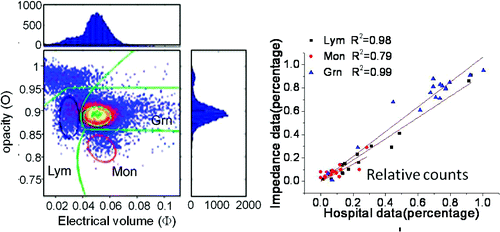Handheld device for doing blood tests moves closer to medical use

Scientists are reporting a key advance in efforts to develop a handheld device that could revolutionize the complete blood cell count (CBC), one of the most frequently performed blood tests used to diagnose and treat disease. In a report in ACS' journal Analytical Chemistry, they describe adding a key feature to their "blood lab-on-a-chip" that allows it to count white blood cells more accurately.
Hywel Morgan, Cees van Berkel and colleagues explain that current CBC technology requires expensive equipment housed in central laboratories, which can take several days to process tests. The CBC test measures levels of the different components of human blood, including red and white blood cells. High or low levels of certain components can indicate a variety of conditions, ranging from infections and anemia to certain forms of cancer. Hoping to make those diagnoses faster and easier, Morgan and van Berkel have been working on a handheld device similar to the blood sugar tests used by people with diabetes.
In their latest advance, the scientists describe successfully adding a new feature to the chip, which sends a blood sample through channels only a few times as wide as a human hair to an electrode that counts blood cells as they pass. The feature breaks down red blood cells in a way that allows the chip to count white blood cells more accurately. Tests on blood samples from patients produced results comparable to those from tests performed on the same samples by a full-scale hematology lab.
More information: Microfluidic Lysis of Human Blood for Leukocyte Analysis Using Single Cell Impedance Cytometry, Anal. Chem., 2012, 84 (2), pp 1070–1075. DOI: 10.1021/ac202700x
Abstract
This paper demonstrates an integrated microfluidic system that performs a full blood count using impedance analysis. A microfluidic network design for red blood cell (RBC) lysis is presented, and the diffusive mixing processes are analyzed using experimental and simulated results. Healthy and clinical bloods analyzed with this system, and the data shows good correlation against data obtained from commercial hematology machines. The data from the microfluidic system was compared against hospital data for 18 clinical samples, giving R2 (coefficient of determination) values of 0.99 for lymphocytes, 0.89 for monocytes, and 0.99 for granulocytes in terms of relative counts and 0.94 for lymphocytes, 0.91 for monocytes, and 0.95 for granulocytes in terms of absolute counts. This demonstrates the potential clinical utility of this new system for a point-of-care purpose.
Provided by American Chemical Society




















